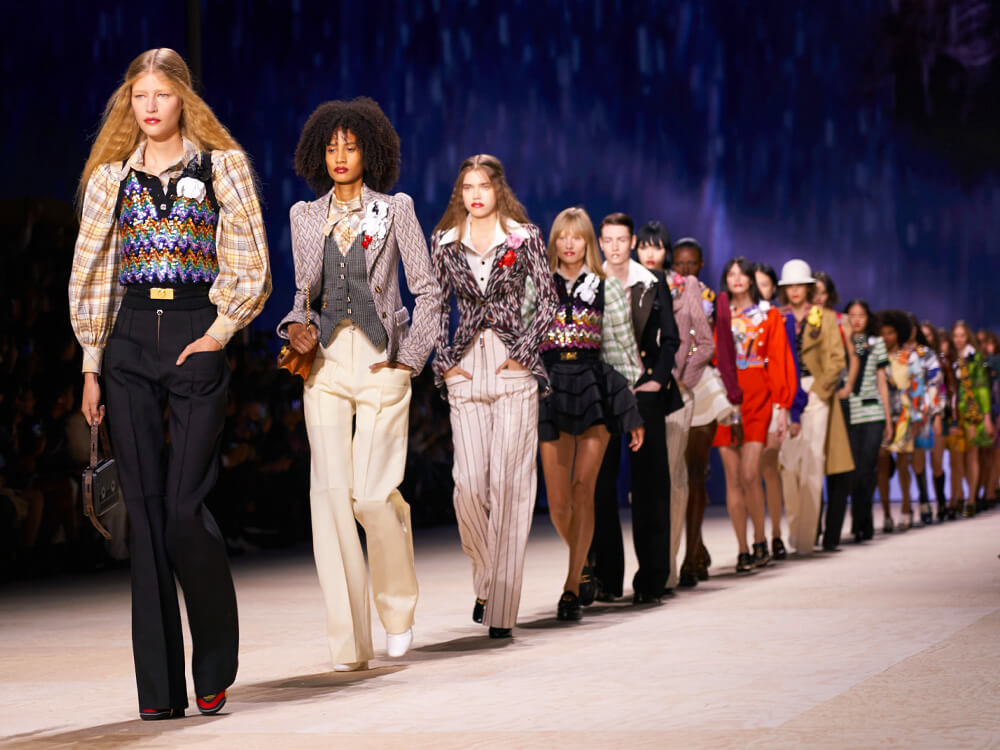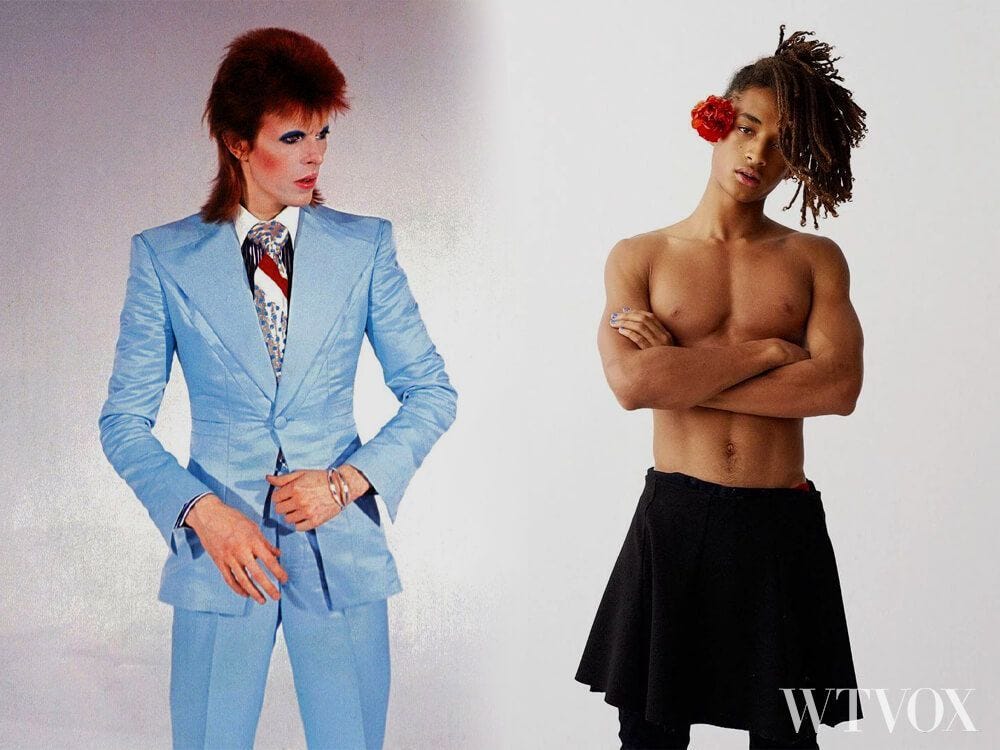Fashion is having an existential crisis in 2020.
The coronavirus pandemic has left the industry on lockdown, facing an uncertain future.
From fashion week cancelled for the foreseeable, to the creation of new collections, and how – or where – they’ll be sold.
A lot of the issues and concerns that the pandemic has brought to light were pre-existing: there’s just a second to stop and think about how actually to address them now.
“This is an opportunity for all of us to look at our industry and our lives, to rethink our values and think about the waste and the amount of consumption,” said Anna Wintour when discussing the state of the industry on Naomi Campbell’s YouTube channel.
“We need to rethink what this industry stands for.“
And, so far, people are trying to do just that whether reexamining the role of influencers, or by trying to reduce their carbon footprints.
Here, we break down the essential takeaways from the chaos, but whether a meaningful change will come from this pandemic remains very much to be seen.
What Has Changed?
The industry has, in many ways, ground to a halt. Orders are stuck in factories, designers and teams are unable to get to their studios, and of course, 2020 fashion week is cancelled.
Students have had their graduate shows axed, young designers are struggling to stay afloat financially, and significant luxury houses have lost sales with stores closed around the world.
Retailers, meanwhile, have clothes stacking up that they haven’t been able to sell. When shops do reopen, there are considerable obstacles to navigate to ensure customers and staff remain safe.
Then there are the fast fashion brands, including Topshop and Primark, which have come under fire for cancelling millions of pounds worth of orders.
The situation has left factories and workers facing a serious crisis although Primark has since promised to create a fund for the workers affected by these cancellations.
And then there are the bankruptcies. Per the Fashion Law’s running list, the companies filing for bankruptcy protection (financial reorganisation in the face of debt) include American department stores J.C. Penney and Neiman Marcus, and casualwear brand J.Crew.
Things have been tough for department stores for a while now, with Barneys closing earlier in the year.
In the UK, the high street has suffered: Oasis, Debenhams, and your mum’s fav, Cath Kidston, have all gone into administration.
Does The System Need Fixing?
That the fashion system is broken is not a new conversation.
As you may remember, the industry has attempted to pivot to a ‘see now, buy now’ model a couple of years ago, and make clothes immediately shoppable straight off the runway.
This conversation isn’t about the exploitative models of fast fashion, but the problems with luxury.
They mostly come down to timing: fashion shows present collections that take six months to get made and sent to stores.
As such, a big window for fast fashion brands is created, allowing them to knock off designs and sell them before the brands do.
The schedule for deliveries to stores is just as confusing. Summer collections arrive at the start of the year, and winter collections come in the summer.
In other words, the clothes currently in the end of season sales are summer collections, despite that summer has barely started.
| Most-Read Articles |
And the longer clothes spend on the sale rail, the shorter window in which they are sold with their original price tags. It is all meant to squeeze on profits.
Then there’s the fact that pre-collections, which are traditionally a more accessible, wearable version of runway collections and fill the gaps between the two main seasons, end up being sold for longer than main collections before being reduced.
Add to that the relentless schedule where large luxury houses may show anything up to eight times a year.
Two men’s and two women’s ready-to-wear shows, two couture shows, a cruise show and potentially pre-fall, as well as shows put on for clients in Asia, and several international travels. Is it too much?
What Is It To Do About It?
In the last couple of weeks, three separate (but, confusingly, overlapping) groups of designers, brands, and retailers have put forward their manifestos for change.
US retailer Saks Fifth Avenue led the first. The second was helmed by Dries Van Noten, who led the publication of an open letter proposing to put the Autumn/Winter season back in winter, and Spring/Summer season back in summer.
Also, to avoid wasteful practices overall, like cutting back on overkill, and unnecessary products.
The letter was signed by big fashion names including Craig Green, Marine Serre, and Grace Wales Bonner.
Two days after Dries’s letter, Business of Fashion unveiled a similar initiative, Rewiring Fashion.
View this post on InstagramA post shared by The Business of Fashion (@bof) on
Rewiring Fashion proposed an entirely new fashion calendar, which would shift when clothes were made, bought by retailers, sold, and marked down.
It also proposed to have two fashion weeks a year in January and June showcasing both menswear and womenswear, rather than the current calendar of men’s in January and June, and women’s in February and September.
“The fashion system must change, and it must happen at every level,” said a joint statement issued this week by the BFC and the CFDA, the two bodies who look after British and American fashion, respectively.
They encouraged brands to “slow down” – focusing on two main collections a year rather than overworking to create more and noted the importance of realigning the fashion calendar with the ‘human’ calendar.
So WTF Is Going To Happen?
For now, it’s all off – at least until September. But tbh, even that feels unlikely. The BFC has plans for a digital platform for June featuring interviews, podcasts, designer diaries, webinars, and digital showrooms from both men’s and womenswear brands.
Saint Laurent has announced it’s going to do things its own shows for the rest of the year, separate from the traditional Paris Fashion Week calendar.
“Once this crisis is over, and non-virtual events can resume, we also recommend that brands attempt to show during the regular fashion calendar and in one of the global fashion capitals“, the BFC/CFDA statement read.
But the Rewiring Fashion report has more significant changes in mind. It proposes that shows become:
“events primarily designed to engage customers, creating awareness and desire for collections just before deliveries arrive in stores.“
Also, it aims to give designers more freedom over what their runway shows look like, a format unchanged for several decades now.
How Sustainable Is This?
Sustainability was central to the BFC/CFDA statement, that advised designers to put:
“the focus on creativity and quality of products, reduction in travel and focus on sustainability (something we encourage of the entire industry)”.
As reported earlier this year in the New York Times, the travel of buyers and brands to international shows and showrooms to buy and sell the collections generated the carbon emissions of a small country.
While jetting editors and influencers to far-flung locales for fashion shows – as is the case for the cruise shows – has been the norm for some time, it’s a practice that increasingly looks outdated.
And, in the face of the pandemic, completely impossible.
How About Consumers?
Unless you’re rolling in it, you might wait for sales to hit to do some shopping rather than buy full price – after all, sales seasons are long, and there are often plenty of discounts and promotions on offer.
But this behaviour is, according to Rewiring Fashion, coming at a cost to brands, in particular, young and independent designers.
“Retailers turn to early and frequent discounts to drive traffic and sales, training the customer to expect perennial markdowns and pull back from full-price shopping, eroding profitability and brand equity for everyone along the value chain.”
Instead, they propose discounts only coming at the end of the season to allow for more full-price selling – so January for Autumn/Winter and July for Spring/Summer, per their new calendar.
When it comes to fashion shows, they could turn into consumer and therefore more public-facing events.
What About Influencers?
The 2010s was the decade of the influencers. But, by the end of last year, there’d been a cultural backlash as readers gleefully shared stories of them. Failing to influence.
When Instagrammer Arielle Charnas took herself to The Hamptons despite testing positive for coronavirus and continued posting despite mounting criticism, it was a nail in the coffin of the 2010s era of the influencer.
View this post on InstagramA post shared by The Business of Fashion (@bof) on
That doesn’t mean they’re going away. Yet, with brands slashing marketing budgets, and influencer activations at risk of looking tone-deaf during the pandemic, we are experiencing what BOF has dubbed the great influencer shakeout; only the strong (with a highly engaged audience) will survive.
And content is pivoting towards the accessible and relatable – away from super exclusive and centred around unaffordable luxury.
WTVOX – ‘Voicing the Future of Fashion’
For more similar content and lightning-quick updates delivered directly to your inbox subscribe to our weekly newsletter.
For daily news in sustainable fashion, innovation, conscious beauty and lifestyle follow us on social media: Instagram, LinkedIn, Facebook, Twitter.
Finally, if you want to interact with thousands like you, join your tribe on the Future of Fashion Group.
A decade of fashion; here’s to the next one.The past decade has been turbulent – and defining – for fashion: child labour, climate crisis, gender inequality, animal cruelty, and reckless plastic pollution, just to name a few. With the COVID-19 pandemic, the beginning of this decade does not look too good either. That’s why finding media that reports with rigour and integrity at heart is difficult in critical times. Finding media that informs all, regardless of where they live or if they can afford to pay, is even harder. In these times, independent fashion media magazines are increasingly silenced by commercial ownership and social media misinformation. So far, your unceasing support has allowed us to keep delivering trustworthy, relevant, high-quality content. Your support allowed us to uphold our editorial independence and ensure honest journalism, free from commercial ownership or political bias. We are deeply grateful for your generosity and continue to count on your support. Thank you. |






